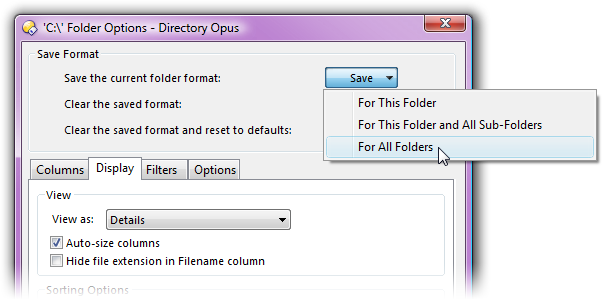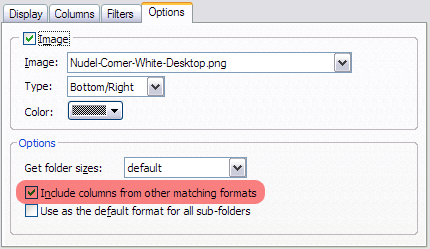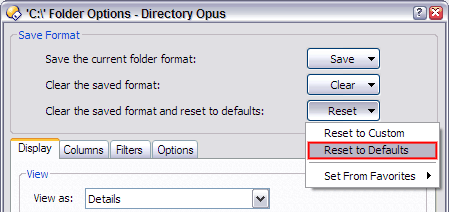This is an old FAQ is for people using Directory Opus 9 or earlier.
There are separate FAQs for Directory Opus 10 and above. See the FAQ List.
Summary: The Folder Format system in Opus is powerful and may appear confusing until some simple concepts are understood.
Quick Guide
If you don't want to read this entire FAQ and just want to use a particular folder format for all folders, without it ever changing, then you only need to do these three things:
[ol][li]Turn off Settings -> Preferences, Folders, Options, Enable Folder Content Type detection since this will change formats automatically when certain types of files are detected and is often the source of confusion.
[/li]
[li]Open an Opus window and set it to use the view mode and columns that you want. Then select Tools -> Folder Options (or click the last button on the default toolbar) to open the Folder Options dialog. From there, click the Save button at the top and then select For All Folders.

[/li]
[li]Go to Settings -> Preferences, Folders, Folder Formats and edit anything under Default Formats which is ticked, ensuring each is set how you want it for each type of folder. (You can untick the ones you don't want to use, except for Custom which is the format used if no other format applies to a folder.)[/li][/ol]
[ul][li]Note that the formats used in special folders, such as My Computer and Desktop, are defined separately. This is covered in a separate FAQ.
[/li]
[li]Formats may also be saved in the Default Lister and in Layouts, Styles and Folder Tab Groups. If you find that you get the format you want except when you open a new window or change Style tabs then that's probably why.
[ul][li]To update the Default Lister, set things as you want them and then use Settings -> Set As Default Lister. Alternatively, to avoid having to do this, you could turn on Settings -> Preferences -> Listers -> Options: Ignore folder format of Default Lister.
(Note: Ignore folder format of Default Lister does not affect folder tabs. If you have folder tabs in your Default Lister then each of them will always store & use its own format as part of the Default Lister.)
[/li]
[li]To update a Layout, open it, modify it as you need and then use Settings -> Lister Layouts -> Save This Lister (or Save All Listers if you want a multi-window layout) and overwrite the old version.
[/li]
[li]To update a Style, modify it as you like and then (assuming you have the Styles tab-bar visible) right-click its tab and choose Update. You can also modify a Style's format and other details via the Settings -> Preferences -> Listers -> Styles.
[/li]
[li]To update a Folder Tab Group, use Settings -> Preferences -> Listers -> Folder Tab Groups, select the group and tab you want to edit and click the Edit Format button.[/li][/ul]If you run into problems trying to change what happens with freshly-opened windows, ensure you understand exactly what is being opened so that you know what needs to be updated. Look through the sections below Settings -> Preferences -> Launching Opus in case you have changed Opus to open something other than the Default Lister.[/li][/ul]Keep reading if you want to know how the Opus Folder Formats system works in detail.
Detailed Guide
[ol][li]The Basics
Open the Opus Preferences dialog, select Folders in the left-hand list and then select the Folder Formats tab at the top. You'll see a list of formats similar to this:
When you make Opus display a directory it will always use one of the formats you see in this list. You can add, edit and remove/disable formats as you desire.
Opus will go through the list from top to bottom until it finds one which can be applied to the folder you are viewing.
If a format has been explicitly saved for a particular directory then that format will be used for that directory, because those formats are at the top of the list.
If the directory doesn't have a format saved explicitly for it then Opus next checks the Content Type formats. These formats kick in automatically if the directory has many files of a matching type. If you don't want this to happen you can disable individual Content Type formats by clicking on their checkbox or you can disable the entire system by going to the Options tab and disabling Enable Folder Content Type detection. You can also elect to enable detection only on certain types of drives.
If none of the Content Type formats apply to the directory then Opus next considers the Default Formats. These formats apply to types of directory and allow you to have different default configurations for local harddrives, network drives, zip files and so on. For example, you may want the versatile and informative Description column displayed for fast local drives but disabled for slow network drives because the overhead of reading files to generate the column's information is too much.
Under Default Formats there is a format called Custom which will always be used when no other format matches the directory you are viewing.
The Favorite Formats section at the bottom is never used automatically; instead it is a place where you can define formats that you apply yourself. You can make a toolbar button or sub-menu (Properties FORMATLIST) which lists these formats so that you can select them when desired without them ever being automatically applied. Within the Preferences dialog you can also use the right-click context menu on an existing format to copy over the details from one of your favorite formats.
If you want to make all folders view using the same format you should start by editing the Default Formats, Custom format and then edit, delete or disable all the others as you see fit.
[/li]
[li]Column Inheritance
If you edit a folder format then, on the Options tab, you'll see a checkbox called Include columns from other matching formats. This checkbox is only visible when you edit a format via the Preferences dialog; it is not visible when editing from a lister via the Folder Options dialog.

If you go to a folder and it matches a format with the Include columns from other matching formats option checked then Opus applies that format but doesn't stop there. In this case Opus will continue looking down the list of formats for others which also match the directory, including Content Type and Default Formats. If another matching format is found then Opus will add in any columns from it that haven't already been included by the first match. If this format also has the include columns... option checked then Opus will continue looking for another, and so on.
[/li]
[li]Sub-Directories
Another checkbox you'll see in the screenshot above tells Opus that a format saved for a particular directory should also be applied to all sub-directories of that folder.
As with the previous option, this checkbox is visible when editing formats via the Preferences dialog but is not shown in the Folder Options dialog. However, if you edit a format using the Folder Options dialog and select Save > For This Folder and All Sub-Folders then the saved format will have the sub-folders checkbox checked.
Of course, the checkbox is also only visible for the first set of formats -- those for specific directories -- since it has no meaning for the others.
[/li]
[li]The Lock Button
In the status bar you'll find a lock icon.
If you click the lock then the current format will be fixed and will not change when you move to other directories, even if they have a specific format defined for them or whatever. Use this when you want to lock the current window into using a different format for some reason. Click the lock icon again when you want to go back to normal.
[/li]
[li]Cached Formats
If you change the format or view mode while viewing a folder then Opus will remember this if you go to another folder and then return to the original via the Back button or folder history.
[/li]
[li]Changes to the Default Formats
Say you are viewing a directory where a Default Format was applied because none of the directory-specific formats, nor the Content Type formats matched. If you make a change to the window by adding or removing columns, setting a different view mode or changing the sort order then your change will continue to be applied, within the current window only, when you go to other folders which pick up the same Default Format.
If you wish to reset the Default Format in the current window back to the way it's configured in Preferences then you should use the window's menus to open the Folder Options dialog and then select Reset to Defaults. Alternatively, just close the current window and open a new one.

Currently, Opus windows will only remember the changes you have made to one of the default formats. If you go to a folder showing a different default format and change that one as well then when you go to a folder showing the first default format you edited it will have reset itself to the configuration in Preferences.
[/li]
[li]System Folders
Configuring system folders like My Computer and Control Panel is covered in a separate FAQ entry.
[/li]
[li]Default Lister, Layouts, Styles and Folder Tab Groups
Formats may also be saved in the Default Lister and in Layouts, Styles and Folder Tab Groups. If you find that you get the format you want except when you open a new window or change Style tabs then that's probably why.
[ul][li]To update the Default Lister, set things as you want them and then use Settings -> Set As Default Lister. Alternatively, to avoid having to do this, you could turn on Settings -> Preferences -> Listers -> Options: Ignore folder format of Default Lister.
(Note: Ignore folder format of Default Lister does not affect folder tabs. If you have folder tabs in your Default Lister then each of them will always store & use its own format as part of the Default Lister.)
[/li]
[li]To update a Layout, open it, modify it as you need and then use Settings -> Lister Layouts -> Save This Lister (or Save All Listers if you want a multi-window layout) and overwrite the old version.
[/li]
[li]To update a Style, modify it as you like and then (assuming you have the Styles tab-bar visible) right-click its tab and choose Update. You can also modify a Style's format and other details via the Settings -> Preferences -> Listers -> Styles.
[/li]
[li]To update a Folder Tab Group, use Settings -> Preferences -> Listers -> Folder Tab Groups, select the group and tab you want to edit and click the Edit Format button.[/li][/ul]If you run into problems trying to change what happens with freshly-opened windows, ensure you understand exactly what is being opened so that you know what needs to be updated. Look through the sections below Settings -> Preferences -> Launching Opus in case you have changed Opus to open something other than the Default Lister.[/li][/ol]Format Examples
Here are some example formats that you may wish to apply to specific directories. The instructions guide you through how to create new formats for a few folders using the Folder Options dialog. After you've saved a format you can open the Preferences dialog and go to the Folders, Folder Formats section where you'll be able to view, edit or delete it and all the other formats.
[ol][li] To set a folder for example, Received Files, to display in reverse data order:[ul][li]Open the folder in a Lister.[/li]
[li] Open the Folder Options dialog (Tools -> Folder Options via the default menu or the last button on the default toolbar).[/li]
[li] On the Columns tab, click the Sort column for the date (modified) field.[/li]
[li] On the Display tab, tick the Reverse sort order checkbox.[/li]
[li] At the top of the dialog, select Save and then For This Folder.[/li][/ul][/li]
[li] Set MyPictures to show thumbnails and sort by shooting time:[ul][li] Open the MyPictures folder in a Lister.[/li]
[li] Open the Folder Options dialog as above.[/li]
[li] Go to the Columns tab and select Pictures in the drop-down, then double click Shooting Time (and any others you want) to move it to the Displayed Fields set.[/li]
[li] Click in the Sort column to sort by Shooting time. (You can also set the sort order on the Display tab as in the previous example. Note that you can only sort by columns in the displayed set.)[/li]
[li] Go back to the Display tab and select Thumbnails in the View as drop-down.[/li]
[li] At the top of the dialog, select Save and then For This Folder.[/li][/ul][/li][/ol]In both examples if you omit the final step where the format is saved and instead just press OK then the format will be used temporarily by the current window without saving it permanently.
Tip: As with the column headers in the file display itself, you can hold Ctrl and click the Sort column if you want to sort by multiple fields:
While on the subject of column sorting, if you're in the file display you can hold Shift and click the Name column to make it sort by file extension. Keep clicking to cycle through modes. (This can't be done via the Folder Formats dialog though.)


